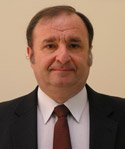LTE Technology Overview for Technical Audiences (Course W-LTE2)
Target Audience, Prerequisites, and Brief Description
This one day e-learning course (pre-recorded webinar) is aimed at technical audience involved in the design and deployment of LTE networks, equipment, or software.
We will start with the evolution of 3G UMTS to 4G/LTE. This will lead to a detailed discussion of all the major components of an LTE system and the motivations behind them. The operational and design goals and challenges of an OFDM-based LTE system are explained. Current LTE frequency bands, overview of radio access, MAC architecture, downlink and uplink channel structure, LTE network access, SAE, and LTE services will be discussed. Upon completion of this basic course, you will be well prepared to delve deeper into LTE through self-directed study or additional Eogogics courses on LTE.
Meet the Presenter: Paul Kakaes
 Dr. Paul Kakaes, a Principal Member of the Eogogics Telecommunications Faculty, is one of the world’s most knowledgeable and dynamic teachers of wireless technologies. With 25+ years in wireless and wireline telecommunications, he brings breadth, depth, clarity, and balance between theory and practice that few in the industry can match. He has taught courses covering all aspects of communication networks to hundreds of diverse groups worldwide. His extensive teaching repertoire includes LTE, WiMAX, OFDM/MIMO, HSDPA/HSUPA, UMTS, GPRS, EDGE, GSM, CDMA 2000 (1xRTT, EVDO), CDMA, iDEN, and TETRA.
Dr. Paul Kakaes, a Principal Member of the Eogogics Telecommunications Faculty, is one of the world’s most knowledgeable and dynamic teachers of wireless technologies. With 25+ years in wireless and wireline telecommunications, he brings breadth, depth, clarity, and balance between theory and practice that few in the industry can match. He has taught courses covering all aspects of communication networks to hundreds of diverse groups worldwide. His extensive teaching repertoire includes LTE, WiMAX, OFDM/MIMO, HSDPA/HSUPA, UMTS, GPRS, EDGE, GSM, CDMA 2000 (1xRTT, EVDO), CDMA, iDEN, and TETRA.
His engaging teaching style brings difficult concepts within the reach of any audience, whether technical professionals or executives trying to understand the intricate world of wireless. In demand around the world, his classes are often accompanied by simultaneous live interpretation into the local language. In class after class, his students continue to shower him with accolades such as the “best class ever” and “best instructor ever.” Read detailed bio…
Detailed Course Outline
- Evolution of UMTS to 4G LTE
- LTE specifications: Current status
- 3GPP UMTS release history and evolution
- LTE design goals and targets
- LTE vs. HSPA+ comparison
- 3GPP LTE Advanced
- LTE: Basic Design Issues
- OFDM: Comparison with single carrier concepts
- Dealing with intersymbol interference and delay spread
- Frequency selective fading
- OFDM and FFT
- OFDMA on the LTE downlink
- LTE generic frame structure
- LTE Frequency Bands
- FDD and Paired frequency bands
- TDD and Unpaired frequency bands
- LTE Radio Access Scheme: Overview of Key Features
- Downlink using OFDM
- Subcarrier spacing
- Downlink modulation formats
- Cyclic prefix: Purpose and duration
- Downlink/Uplink reference signals
- Channel coding
- MIMO operation
- Uplink using Single-Carrier (SC) FDMA
- Uplink modulation formats
- Scalable bandwidths
- Adaptive channel-dependent scheduling
- LTE Protocol Architecture: Medium Access Control (MAC)
- Logical, transport and physical channels
- Downlink and uplink channel mapping
- Dynamic scheduling procedures
- Hybrid ARQ and soft combining
- LTE Network Access
- Acquisition and cell search
- System information
- Random access procedures
- Paging
- System Architecture Evolution (SAE)
- Evolved Packet Core (EPC) network architecture
- Mobility Management Entity (MME)
- UE handover measurements
- WCDMA/HSPA and the Evolved Packet Core (EPC)
- Non-3GPP and the Evolved Packet Core (EPC)
- Course Wrap-up: Recap, How to Learn More about LTE, Q/A
